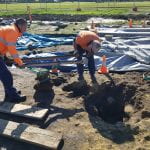The archaeological excavations of the Port Arthur workshops are a collaborative project between the Port Arthur Historic Site Management Authority (PAHSMA) and Dr Richard Tuffin, Postdoctoral Research Fellow from the University of New England. The work is part of a suite of archaeological investigations that have taken place in and around the Penitentiary precinct since 2013. Between 2013-15 archaeologists were part of conservation and interpretation works which took place throughout the main structure and the Penitentiary muster ground. In 2016 a large open-area excavation was carried out of the site of the former ablutions, exercise and laundry areas. All these excavations have told us new things about how the site evolved, how convicts were managed and how they reacted to this management. The investigations of the workshops will provide similar insight, as well as help us understand how convict labour was used and what were the processes and products.
Our 2020 investigations are also part of a wider and ongoing research project into convict labour which has been continuing for a number of years. Since 2017 we have been researching the important role that labour played in the Australian convict system through a large Australian Research Council project Landscapes of Production and Punishment: the Tasman Peninsula 1830-1877. This collaborative project has involved researchers from UNE, PAHSMA, the University of Tasmania and the University of Liverpool (UK) using archaeological and historical evidence to examine how landscape and space affected the labour experience of convicts incarcerated at a number of stations – Port Arthur included.


